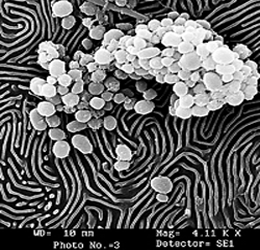11.4 Drying
After dehydration, specimens are dried and there are different approaches of drying:
Air drying
Critical point drying
Freeze drying
www.tswatches.me
11.4.1 Air drying
It is the simplest method of drying, though it creates maximum distortion. It causes flattening of specimen surface because of compressive forces of surface tension of liquid-gas interface.
11.4.2 Critical point drying
This is the most commonly used technique to dry biological samples. The sample is transferred from an organic dehydration medium (acetone) to drying medium (liquid CO2 or Freon 13) in a chamber that is cooled and put under pressure. When the dehydrating agent (acetone) has been completely removed and impregnated with the liquid CO2, the chamber is warmed up to the critical point where the density of the drying medium is same in both liquid and gas phase. Phase boundary disappears and CO2 can be released gradually to avoid condensation. The sample is then dry.
The most commonly used medium for critical point drying are:
CO 2 - Critical point 31.5o C at 1100 p.s.i. (pressure)
Freon 13 - Critical point 28.8o C at 560 p.s.i. (pressure)
11.4. 3 Freeze drying
Unfixed as well as chemically fixed samples can be freeze-dried. Freeze drying consists of the sublimation of ice from cells and tissues under vacuum. To do this, frozen samples are placed on a cooled specimen holder in the vacuum chamber. Start from -100o C and raise the temperature slowly to -70o C or -60o C. Under these conditions a cell monolayer can be freeze-dried within 72 hours.
11.5 Specimen mounting
After drying, the specimens are mounted and coated as early as possible. Specimens are mounted on to the aluminium stubs with conductive paint or adhesive tape. While mounting, following points should be taken care of:
· Conductive paint should not come over the surface to be scanned,
· Paint should not lose its adhesive properties and should be able to withstand tilting.
· It should make good electrical contact with both specimen and stub.
Large specimens can be stuck directly on to the stub with the help of conducting paint (silver or copper paint). For smaller specimens, the stub is first covered with a piece of double-sided adhesive tape and the specimen is stuck down onto this with the help of a magnifier or binocular microscope. Specimen should be oriented in such a way that the area of interest is optimally exposed to the electron beam.
11.6 Metal Coating
Biological specimens are poor electrical conductors. They develop electrical charge when scanned by high-energy electron beam. This leads to charging artifacts, distorting the image. Conductivity can be increased if the specimen is coated with a thin layer (15-30 nm) of metal.
Metal coating also increases:
· Mechanical strength of fragile biological material.
· Number of secondary electrons emitted from specimen surface, which leads to improvement in image formation.
Metals commonly used metals for sputter coating are silver, gold, gold-palladium, platinum etc. Coating can be done in two ways:
· Thermal evaporation
· Sputter coating
11.6.1 Thermal evaporation
Many metals, when heated in vacuum, evaporate rapidly into a monoatomic state. The high temperature required to start evaporation of the materials can be achieved by resistive heating.
· The specimen is mounted on a rotating specimen stage to get even coating.
· Thin wire of metal to be evaporated is wrapped around a tungsten filament.
· The chamber is evaculated.
· The tungsten filament is heated by applying voltage.
· Metal will start evaporating and a thin layer will deposit on the rotating specimen.
Under best conditions, the coating may be relatively uneven and the chances of surface charge accumulation are higher, hence most people prefer sputter coating.

